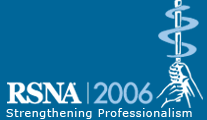
Abstract Archives of the RSNA, 2006
SSM11-01
Interventional Barium: The Use of a Provocative Food Study Compared to Barium Alone to Assess Functional Disorders of the Alimentary Tract
Scientific Papers
Presented on November 29, 2006
Presented as part of SSM11: Gastrointestinal (Fluoroscopy)
Ashraf Thabet MD, Presenter: Nothing to Disclose
Jack Wittenberg MD, Abstract Co-Author: Nothing to Disclose
Deborah A. Hall MD, Abstract Co-Author: Nothing to Disclose
Peter Florin Hahn MD, PhD, Abstract Co-Author: Nothing to Disclose
Douglas Mathisen MD, Abstract Co-Author: Nothing to Disclose
Peter Raff Mueller MD, Abstract Co-Author: Consultant, Cook Group Incorporated, Bloomington, IN
To evaluate the utility of provoking symptoms with barium-coated food under fluoroscopy compared to barium alone in order to identify functional abnormalities of the alimentary tract.
29 patients (20 women, 9 men) underwent a food provocation study. Patient records were reviewed for prior surgeries and presenting symptoms. Patients brought food known to elicit their symptoms. A single contrast upper GI series with thin barium was performed first, followed by food with barium. Reproduction of symptoms (ROS) was noted. Alimentary tract function was examined for altered peristalsis (e.g., aperistalsis), hold-up of food, and luminal narrowing.
66% (19/29) had prior surgery, including esophagectomy, gastrectomy, fundoplication, gastric bypass, Whipple procedure, and tracheoesophageal fistula repair. Presenting signs and symptoms were dysphagia 57%, abdominal pain 30%, odynophagia 20%, nausea/vomiting 17%, heartburn 10%, weight loss 10%, and recurrent aspiration 3%.
90% (26/29) did not have ROS with barium alone. With food, 50% (13/26) had ROS. In the 3 patients who had ROS with barium-only, 2 (67%) described worsening of symptoms with food.
48% (14/29) had a fluoroscopic abnormality (FA) with barium only; 93% (13/14) of these patients had additional or more prominent FA with food. Of 15 patients who had no FA with barium only, 7 (47%) demonstrated one after food. Abnormalities included altered peristalsis in 69% (20/29), luminal narrowing (esophagus, pylorus) in 10% (3/29), reflux alone in 8% (2/29), and a grapefruit-sized epiphrenic diverticulum in 3% (1/29). There was functional obstruction, in which there was hold-up of food within esophagus, stomach, or bowel, in 58% (17/29).
Of 24 patients who had ROS and/or FA, 33% (8) went to surgery (gastroplasty, esophagectomy, pancreaticojejunostomy revision, fundoplication, epiphrenic diverticulum excision), 17% (4) underwent endoscopic dilation, and 33% were treated medically.
Food with barium may better elicit symptoms and demonstrate a fluoroscopic abnormality compared to barium alone.
A provocative food study may better help to characterize alimentary tract dysfunction and guide therapy compared to barium alone.
Thabet, A,
Wittenberg, J,
Hall, D,
Hahn, P,
Mathisen, D,
Mueller, P,
Interventional Barium: The Use of a Provocative Food Study Compared to Barium Alone to Assess Functional Disorders of the Alimentary Tract. Radiological Society of North America 2006 Scientific Assembly and Annual Meeting, November 26 - December 1, 2006 ,Chicago IL.
http://archive.rsna.org/2006/4437913.html

